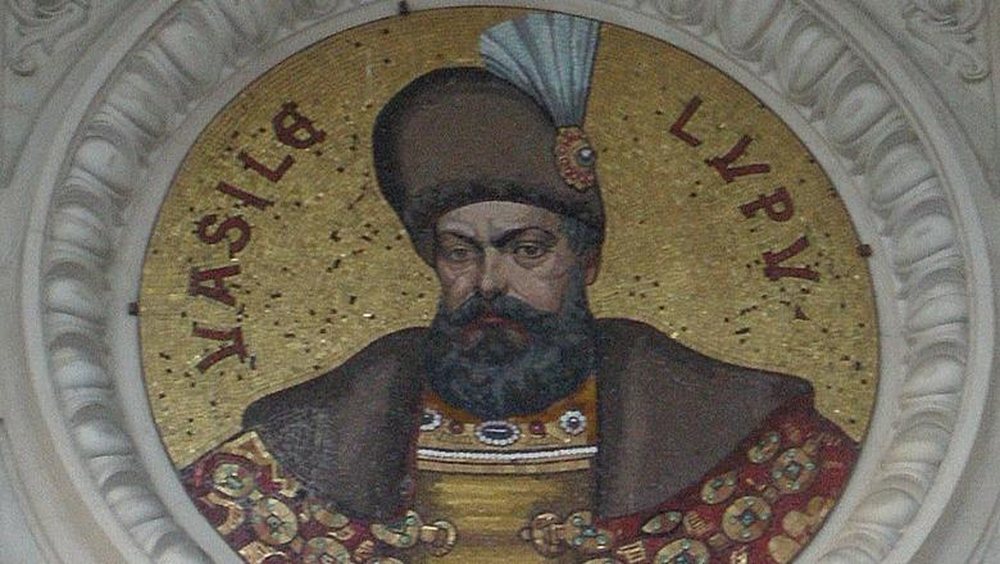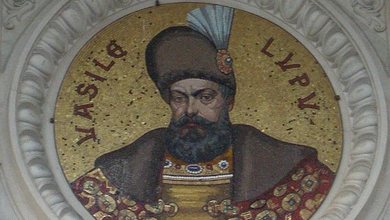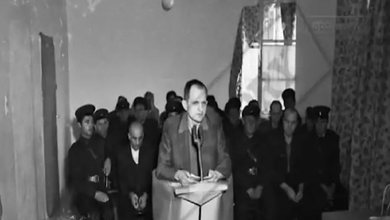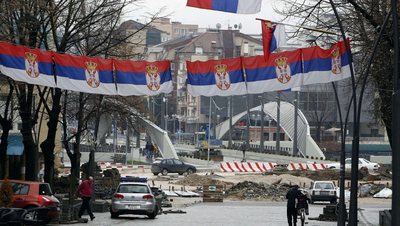
Vasile Lupo, ruled Moldavia in two periods: April 1634-April 1653; April 1653-July 1653. His name was Ujku Koçi and later his name turned into a surname being called Vasile Lupo. He was of Albanian origin with the surname Koçi, and came with his father, Nikoll Koçi to Wallachia (1611), during the reign of Radu Mihnea (1611–1616), then to Moldavia. He had two brothers: Gheorghe, who became a great glassmaker, and Gavriil, who became a hatter, as well as a sister, Marga. Lupu married Tudosca, daughter of the great Vornico of Holland, Costea Bucioc. After the death of his wife, Tudosca, he married Ecaterina, a beautiful Caucasian woman, with whom he had a son, Ştefăniţă, later lord of Moldavia.
He held important positions in Moldavia: Grand Treasurer (today this role could be considered Minister of Finance for the time) (1620–1621), Commissioner (1621), Grand Back (1626–1627), Grand Treasurer again (1627–1628), Grand Hatter (1629–1630) and Grand Keeper of the Netherlands (1630–1633). He ascended the throne after deposing Miron Barnovschin, with the support of Portia. Becoming a lord, he took the name Vasile Vodă. Dimitrie Cantemir wrote of Vasile Lupu: "...During the reign of Vasile Albanezul (the Albanian), Moldavia... began to awaken and slowly emerge from the deep darkness of barbarism.
After ascending the throne, Vasile Lupu appointed many of his relatives to the Royal Council (10 out of 17 governors were his close relatives). He encouraged the influx of some Greek and even Albanian elements into the Council (the future Lord Gheorghe Ghica, originally a modest fish merchant).
Catholic missionary Marco Bandini, who visited Moldavia during the reign of Vasile Lupu, echoed the sovereign's words: "If you all commit an act deserving death, you will undoubtedly have to die. Even if half of Moldavia were evil, the evil part would disappear, so that the good would be preserved. With the good I will live safely, with the evil I will always be in danger."
The domestic activities of this Lord covered a very wide spectrum. He increased taxes, thus securing large revenues; he maintained, with money, the goodwill of the Porte, maintained a relatively large army and a special splendor at the Royal Court. His main quality was that of a good family head: he restored the princely courts of Iași and Suceava, and maintained and restored the fortresses.
To restore the country's demographic potential, he encouraged the creation of "sloboziv" with 10-year exemptions from rents, from which came settlers from Transylvania and Russians (Ruthenians) under Polish rule. But his main activity, through which he entered the consciousness of his contemporaries and the gallery of great masters, was that of the protector and founder of all Orthodoxy: he donated large sums of money to the Patriarchates of Constantinople and Jerusalem and the monasteries of Mount Athos, organized at his own expense an Orthodox ecumenical synod in Iași (1642), where the dogmatic document Orthodox Confession was drawn up, drafted by the adopted Metropolitan of Kiev Petru Movilă; founded and restored about 30 places of worship in Moldavia (including the Trei Ierarhi and Golia monasteries in Iași), built the church of Saint Dumitru of Orhei.
Lviv and Kiev; brings the relics of Saint Paraskeva from Constantinople to Iasi; intervenes in the election of the patriarchs of Constantinople, Jerusalem and Alexandria.
In 1640, on the initiative of Vasile Lupu, the Slavic-Greek-Latin Academy, also known as the "Vasilian College", was founded in Iași, where young people received training and education. The foreign traveler Paul Beke, who was in Moldavia in 1644, noted that the ruler of this country "has built new stone schools of special dimensions... so that the young people can be initiated into culture and morality". Vasile Voievod also supported Metropolitan Varlaam in his extensive cultural activity. The first printing house was founded in Moldavia in 1642, with the support of Petru Movilă and the Kiev printers. The following works were published here: The Cauldron of Varlaam (1643); The Seven Mysteries of the Church (1644); The Reign of Vasile Lupu (1645); Bucoavna (1651), etc.
During the reign of Vasile Lupu, the judicial system was modernized. Through the "Regulation of Vasile Lupu", Moldavia moved from unwritten law ("customs of the land") to written law. This was the first legal code in Moldavia, drawn up based on the development of Roman-Byzantine legal norms.
He had good relations with the Prince of Transylvania, Gheorghe Rákóczi I, with whom he concluded a treaty of equality (1638), renewed in 1646. Obsessed with the idea of obtaining the princely seat in Muntenia for his son Ioan or for himself, he tried, with the tacit permission of the Turks, using both intrigue and diplomacy, as well as armed intervention, to remove Matei Basarab from his kingdom. However, the latter managed (in the Battle of Focşani (1637), the Battle of Ojogen (1639) and the Battle of Finta (1653)) to take revenge on the battlefield and at the Porte, causing great inconvenience to Vasile Lupu at the Porte. In 1644 he made peace with the ruler of Muntenia. In commemoration of this agreement, Vasile erected the Stelea church in Tîrgoviște, and Matei Basarabi that of Soveja, in Moldova.
Towards the end of Vasile Lupu's reign, he formed an alliance with the Zaporizhian Cossack ataman, Bogdan Khmelnytsky. Vasile Lupu was not familiar with the aspirations of the Zaporizhian Cossacks. But political circumstances forced him to yield to Bogdan Khmelnytsky's pressure. In order to bring Voda to its knees, in the autumn of 1650, the ataman, in collaboration with the Tatar innkeeper Islam Ghiray, plundered and burned the villages and towns of Moldavia. Two years later, in 1652, Vasile Lupu, on the orders of the boyars, sacrificed his daughter, Lady Ruxandra, marrying her to Timuş Khmelnytsky.
Vasile Lupu lost his kingdom after the uprising of the great boyars led by Gheorghe Ştefan (1653), dissatisfied with the policy of promoting the lord's relatives. Vasile Lupu's attempts to regain and maintain his rule, with the help of the Cossacks, failed.
He went into exile among the Crimean Tatars, then to Istanbul, where he lived until the end of his life (1661). He was imprisoned by the Turks in the famous Seven Towers fortress "in the papacy, not in prison". In old age, he still had a great enthusiasm for life. His son, Ştefăniţă, became lord of Moldavia in 1659, but lost it soon after his father's death in 1661.
Furthermore, Vasile Lupu was appointed the master of the Three-Year Church of Iași.
Vasile Lupo, not only ruled, but created modern "Moldova". In fact, one of his most important contributions that have an important role in today's Romania and Moldova, is the fact that he made the first codification of laws. The laws or norms codified by Vasile Lupo were different from the unwritten norms that applied in different areas of the country, because these codes or written rules were rules similar to those of Byzantium. He made his essential contribution by creating for the first time a text with uniform rules that regulated the private, public, economic and criminal life of that time. Vasile Lupo's code was similar to the Kanun of Lekë Dukagjini and had Justinian's norms as a reference. Of course, since this was an innovation for the area and the fact that norms and rules were codified for the first time, this is certainly also related to his Albanian origin.
Vasile Lupu introduced the first written laws in Moldavia (1646, published in Iași). Known as the Carte româneascǎ de învățătură ("Book of Lessons") or Pravila lui Vasile Lupu ("Code of Vasile Lupu"), the document did not go against the traditions of the Byzantine Empire, being a translated revision of these (and almost identical to the contemporary Wallachian equivalents).
The Romanian Civil Code also has the customary law of the Vasile Lupo "Code" among its sources, writes the Albanian.
So, once again we have figures like Vasile Lupo, who of Albanian origin makes extraordinary contributions to the building and modernization of a kingdom by writing its laws for the first time.














